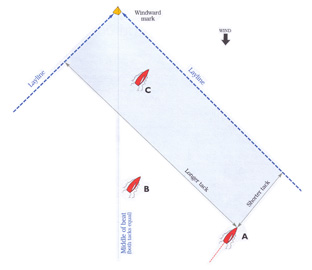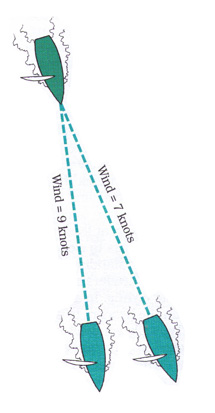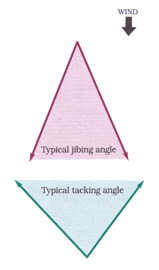|
Rule of Thumb: Sail the longer tack first
by David Dellenbaugh
My favorite rule of thumb, and one
that I have used with great success
many times, is to 'sail the longer tack
first.' This is a simple, nearly foolproof
guideline that is easy to use and often
comes with great results.
When you're racing upwind, the
'longer tack' is the one on which you must
spend more time to get from where you
are to the windward mark. There are
many reasons why one tack may be
longer than the other. Most often, this
happens because you have sailed away
from the middle of the course.
For example, if you sail toward the
left side of the beat you might have 4
minutes left on starboard tack and 8 minutes
left on port tack before reaching the
windward mark. In that case, port is obviously
the longer tack. Other reasons for
unequal tacks include windshifts, a crosscurrent
and a windward mark that was
not set to windward.
The longer tack is the one on which
your bow is pointing closer to the windward
mark. Sometimes it is easy to judge
this by looking at where other boats are
pointing on each tack. If you have instruments,
or even a compass, you can calculate
the longer tack mathematically.
Besides figuring out which tack is
longer, it's important to know roughly
how much longer it is than the other tack.
For example, will you have to spend 10
minutes on one tack and 2 minutes on the
other? Or just 7 minutes on one tack and
6 on the other?
The more skewed the tacks, the more
critical it becomes to sail on the tack that
is longer. If one tack is much longer, there
is a high probability that it will be better
to get on that tack right away. But if the
tacks are very close in length (which is
probably the case if you have a hard time
figuring out which tack is longer), there
may be no advantage in sailing one tack
just because it's a little longer.
When and why this works
'Sailing the longer tack first' is a rule of
thumb that works most of the time.
However, like all such guidelines, it is not
meant to be a replacement for figuring
out what the wind is doing and making
your own strategic plan to handle the particular
wind conditions you are facing.
For example, if it's light air and you see
more pressure to the left, you should
probably sail that direction on starboard
tack even if port tack is a lot longer.
However, when you are not so sure
about what the wind will do next (and this
is the case even for top sailors much of
the time), then you can rely on rules of
thumb like 'sail the longer tack first.' This
principle works because when the wind
might shift in either direction it's better to
stay away from the layline. By sailing the
longer tack first, you head toward the
middle of the beat rather than the closer
layline.
Playing the odds
 Sailing the longer tack first is a
good rule of thumb when you are
not sure which way the wind will
shift next. The longer tack takes
you away from the layline and
gives you a better chance of gaining
if you get a windshift before
you reach the windward mark.
Sailing the longer tack first is a
good rule of thumb when you are
not sure which way the wind will
shift next. The longer tack takes
you away from the layline and
gives you a better chance of gaining
if you get a windshift before
you reach the windward mark.
The benefits of this strategy are greatest when the following conditions
exist:
1) The distance you must sail on one tack is substantially longer
than the distance remaining on the other tack. For example, if you have
7 minutes to sail on starboard tack and only 2 on port (A), it's very likely
that sailing the longer tack first will be better. But if you are closer to
the middle of the course with 4 minutes to sail on one tack and 3 minutes
on the other (B), there may not be much advantage in sailing the
longer tack first.
2) You are fairly far from the mark. The closer you are to the mark
(C), the less of an advantage you'll get from sailing the longer tack first.
That's because the wind is less likely to shift during the short time before
you round the mark. In this case it's often best to minimize the number
of tacks you make and to position yourself ideally relative to the boats
around you.
Corollary: Sail the longer jibe first
 For the same reasons that you should normally sail the longer tack first on a beat, you
should also sail the longer jibe first on a run. Getting to the downwind layline too early
has all the same problems - the risk of sailing extra distance, possible bad air and the
inability to play future windshifts (when you're not sure what the wind will do).
For the same reasons that you should normally sail the longer tack first on a beat, you
should also sail the longer jibe first on a run. Getting to the downwind layline too early
has all the same problems - the risk of sailing extra distance, possible bad air and the
inability to play future windshifts (when you're not sure what the wind will do).
In fact, this rule of thumb may be even more important on runs than beats because
it's easier to overstand downwind. Most boats have narrower jibing angles than tacking
angles (right), so when you round the windward mark you are already closer to a layline.
All you need is a slight skew in the course, a windshift, pressure increase or a crosscurrent
and you'll be at layline before you know it.
 LEFT: Even a small increase in wind velocity can have a large
impact on your downwind angles. Therefore, you have to
allow for this when positioning yourself on the run. If you
get too close to a layline and get a puff, you will be overstanding
the leeward mark.
LEFT: Even a small increase in wind velocity can have a large
impact on your downwind angles. Therefore, you have to
allow for this when positioning yourself on the run. If you
get too close to a layline and get a puff, you will be overstanding
the leeward mark.
RIGHT: Boats with symmetrical spinnakers
typically have narrower jibing angles than
tacking angles in almost every wind
velocity. So it's easier to get to a
downwind layline, especially in
breeze when the jibing angle
is very small.
Over the course of many races in the
past, this strategy has proven to work
more often than not. In other words, it
gives you a higher probability of success,
which is very important when you are trying
to minimize your exposure to risk.
The probability that this rule of
thumb will work goes up as: a) the tacks
become more uneven; and b) you are farther
from the mark (see “Playing the
odds”). If you are quite far from the windward
mark and the tacks are quite
skewed, it is very urgent to sail on the
longer tack.
Note that if you have a cross-current
(a current the runs perpendicular to the
wind), this will often make one tack
longer than the other, sometimes by quite
a bit. In that case, it may be better to sail
the up-current tack first. This is not
because there is any inherent advantage
to being up-current - it just keeps you
closer to the middle of the course, which
is better when you're not sure what will
happen next with the wind.
Dave publishes the newsletter
Speed & Smarts. For a subscription
call: 800-356-2200 or go to:
www.speedandsmarts.com
TOP
|